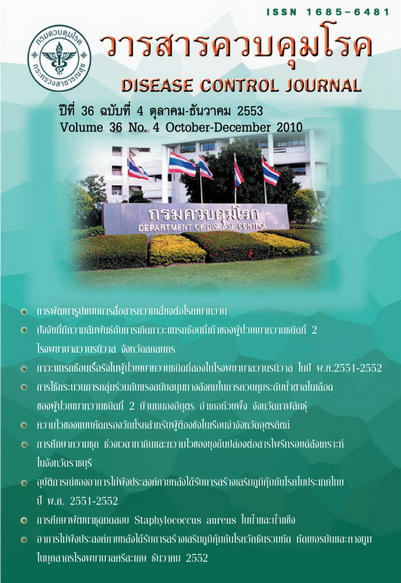The Sensitivity of the Tuberculosis Verbal Screening Tool for the Prisoners in Uttaradit Jail
Keywords:
Sensitivity of the Tuberculosis Verbal Screening Tool, Prisoners, Uttaradit JailAbstract
The objective of this research was to study sensitivity of the tuberculosis verbal screening tool recommended by Bureau of Tuberculosis , Department of Diseases Control. The eligible population in the study included 856 prisoners in Uttaradit jail during 10 - 11 July 2009. The verbal survey for tuberculosis was used to interview all the prisoners. The diagnosis of tuberculosis were done by chest X-rays, AFB sputum examination by microscope and sputum culture for tuberculosis bacillus. It was found that the majority of Uttaradit prisoners (74.8 percent) had no symptoms. The results of chest X-rays showed 41 cases of abnormal infiltration (4.8 percent of all). The results of AFB Sputum examination by microscope and sputum culture for tuberculosis bacillus found 15 cases of sputum positive for tuberculosis (1.75 percent). 6 cases were identified as active pulmonary tuberculosis (0.70 percent) and 9 cases were indentified as smear negative pulmonary tuberculosis (1.05 percent). Among pulmonary tuberculosis cases , 12 cases (80.0 percent) had no symptom of pulmonary tuberculosis and 3 cases (20.0 percent) had only 1 criteria. The sensitivity of the screening tool for Uttaradit prisoners who had positive findings by chest X-rays ( suggestive pulmonary tuberculosis ) showed that one of the symptom or more of the screening tool had sensitivity of 36.6 . The symptom of coughing more than 2 weeks , coughing up blood, fever more than 2 weeks and weight loss 3-5 kilograms per month had sensitivity of 14.6 , 4.9 , 9.8 and 2.4 respectively. The symptom of sweats at night showed zero sensitivity for chest X-rays in Uttaradit prisoners. The symptom of one or more of the screening tool, coughing more than 2 weeks, coughing up blood, fever more than 2 weeks had significantly relation to positive chest X-rays ( p-value <0.05 ). The symptom of sweats at night and weight loss 3-5 kilograms per month had no relation to positive chest X-rays. The suggestion of screening test to identify the suspected cases from population and refer to doctor for definite diagnosis and proper treatment should have both high sensitivity and specificity. The findings of this study found that the 5 verbal screening clauses recommended by Bureau of Tuberculosis had low sensitivity which would miss many pulmonary tuberculosis patients. Crowded and poor ventilation in prison caused high chance of tuberculosis spreading. Death from delay treatment could occur in severe cases of tuberculosis. Current verbal screening tool was not sensitive enough for tuberculosis, therefore chest X-rays should be suggested to perform for all, annually at least. There was a need to develop a more sensitive verbal screening tool to be used in high prevalent area such as prison.
Downloads
References
2. Center for Disease Control and Preventional . Reported tuberculosis in the United States, 1998. 1999 August: [cited 2002 Oct 14] . Available from: URL: http://www.cdc.gov/mchstp/tb.
3. สำนักวัณโรค กรมควบคุมโรค กระทรวงสาธารณสุข แนวทางการเร่งรัดการควบคุมวัณโรคในเรือนจำของประเทศไทย. พิมพ์ครั้งที่ 2. กรุงเทพมหานคร: สำนักพิมพ์อักษรกราฟฟิคแอนด์ดีไซน์ , 2552.
4. ประวิทย์ สุนทรสีมะ, นราพร พิชัยณรงค์. วิทยาการระบาดและการควบคุมโรคติดต่อ. กรุงเทพมหานคร: ห้างหุ้นส่วนจำกัด ธนะการพิมพ์ 2531.
5. สำนักโรคเอดส์ วัณโรคและโรคติดต่อทางเพศสัมพันธ์. แนวทางการดำเนินงานชันสูตรวัณโรคแห่งชาติ. พิมพ์ครั้งที่ 4. กรุงเทพมหานคร: โรงพิมพ์การศาสนา: 2547.
6. ภาสกร อัครเสวี. ระบาดวิทยาและแนวโน้มของวัณโรคในประเทศไทย. ใน: บัญญัติ ปรัชญานนท์, ชัยเวช นุชประยูร, สงคราม ทรัพย์เจริญ (บรรณาธิการ). วัณโรค. พิมพ์ครั้งที่ 4 (ฉบับปรับปรุง) กรุงเทพมหานคร: โรงพิมพ์แห่งจุฬาลงกรณ์มหาวิทยาลัย, 2542. หน้า 31-63.
Downloads
Published
How to Cite
Issue
Section
License
Articles published in the Disease Control Journal are considered as academic work, research or analysis of the personal opinion of the authors, not the opinion of the Thailand Department of Disease Control or editorial team. The authors must be responsible for their articles.


.png)



